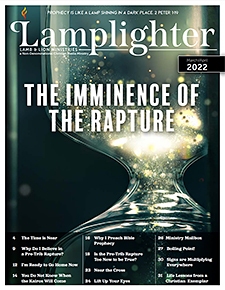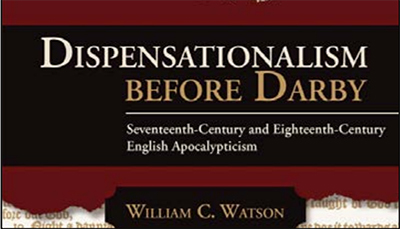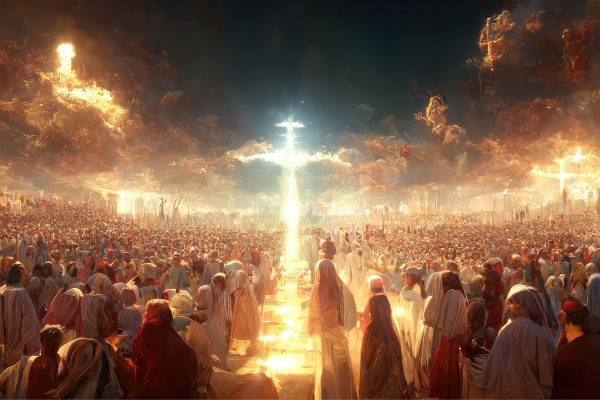Is The Pre-Trib Rapture Too New To Be True?
The Origin of Pre-Trib Viewpoint

A common rebuttal to the concept of a Pre-Tribulation Rapture is that it is “too new to be true.” This argument is based on the assumption that the doctrine was not developed until the early 1800s by a man named John Nelson Darby who was a leader among the Plymouth Brethren in England.
This assumption is not correct, but even if it were true, it would not invalidate the concept. The only true test of any theological doctrine is whether or not it lines up with the Scriptures. Furthermore, there are some very valid reasons why the concept of a Pre-Trib Rapture developed late in the history of the Church.
Societal Reasons for Delay
For one thing, in the early 5th Century, the Catholic Church adopted Augustine’s Amillennial interpretation of end time prophecy as the Church’s official end-time viewpoint.1 That meant that for the next thousand years, if anyone had the audacity to challenge that viewpoint, they risked being burned at the stake, together with their writings. So, we really have no idea how many people during that time may have come up with the idea of a Rapture separate and apart from the Second Coming and happening before the Tribulation.
Further, the Catholic Church kept the Bible from the masses. The church argued that only those ordained by the church had the right to interpret the Scriptures.
Also, Bibles had to be produced by hand, and were too expensive for the average person to purchase. And even if they had been available, the average person during the Middle Ages could neither read nor write (only 5% of the European population had any formal education by 1330).2 So, all they knew about the Bible was what the church shared with them, which was mainly the story of Jesus.
Serious public study of the Bible had to await several developments:
- The invention of the printing press in 1440, which made it financially feasible to get printed Bibles.
- The Reformation in 1517, which broke the domination of the Catholic Church.
- The translation of the Bible into the common languages of Europe — like English by William Tyndale and German by Martin Luther.
- The spread of literacy.
And speaking of the Reformation, when Luther had his confrontation with a Vatican representative at the Diet of Worms in 1521, he was told that his concept of “salvation by grace through faith” was “too new to be true” because it could not be found in the writings of popes, priests or Church Fathers.3 Luther responded by asserting that his doctrine could be found in the writings of a far more important person — namely, the Apostle Paul!4

A Biblical Reason for Delay
But there is another and more important reason for the delay in the development of the Pre-Trib Rapture concept, and it is a biblical one. The Lord told both Jeremiah and Daniel that many end time prophecies would not be understood until the time came for them to be fulfilled (Jeremiah 23:20, Jeremiah 30:24 and Daniel 12:8-9).
Here’s how the Lord expressed this truth to Daniel:
As for me, I heard but could not understand; so I said, “My lord, what will be the outcome of these events?” He said, “Go your way, Daniel, for these words are concealed and sealed up until the end time” (12:8-9).
Again, the chronological development of a biblical doctrine is not the true test of its validity. One of the earliest doctrines developed among the Church Fathers was the concept of salvation by baptism, or “water regeneration.” The fact that it was an early doctrine did not make it true.
Nor would the recent development of the Pre-Trib doctrine invalidate it. As prophecy scholar Dr. Andy Woods has put it, “Consistency with the Scriptures determines an idea’s truthfulness, and not when the idea originated.”5
Recent historical events, like the re-establishment of Israel, and modern day technological developments, like the invention of nuclear power, are helping us to understand Bible prophecies that have never been understood before.
But the most important key has been the revival of literal interpretation. This natural way of interpreting the Scriptures characterized the early Church Fathers, but it was abandoned when Amillennialism became the endtime viewpoint of the Roman Catholic Church. From about 450 AD to the Reformation in the 1700s, Bible prophecy was spiritualized and interpreted allegorically. Many new discoveries have been made in Bible prophecy since the 1700s, simply because people started accepting the prophecies to mean what they say.
So, we are not talking about novel new truths. We are talking instead about the discovery of truths that were always in the Scriptures, but which were muddled by spiritualization or which awaited historical developments or technological discoveries.
The Origin of Pre-Trib Viewpoint
Premillennialism was the dominant view among the early Church Fathers, and although the vast majority of them did not have any concept of a Pre-Trib Rapture, they did have a very strong belief in imminence — meaning they believed that the Lord could return any moment.
For example, Paul exhorted the Christians in Corinth to be “awaiting eagerly the revelation of our Lord Jesus Christ . . .” (1 Corinthians 1:7). James, the brother of Jesus, warned the Jerusalem church to “. . . be patient; strengthen your hearts, for the coming of the Lord is near . . . behold, the Judge is standing right at the door” (James 5:8-9). Peter urged his readers to “. . . prepare your minds for action, keep sober in spirit, fix your hope completely on the grace to be brought to you at the revelation of Jesus Christ” (1 Peter 1:13). And even Jesus Himself cautioned that He might return at any moment. Consider His statement recorded in Matthew 24:36 and 42 — “But of that day and hour no one knows, not even the angels of heaven, nor the Son, but the Father alone . . . Therefore be on the alert, for you do not know which day your Lord is coming.”
Expressions of imminency abound in the writings and sermons of Church Fathers like Clement of Rome and Ignatius of Antioch, both of whom lived in the First Century. Statements about the Lord’s imminent return can also be found in early publications like The Didache (60-100 AD), The Epistle of Barnabas (130-131 AD), and The Shepherd of Hermas (110 AD). This latter publication actually contains a pre-tribulational concept of escaping the Great Tribulation: “If then you prepare yourselves, and repent with all your heart, and turn to the Lord, it will be possible for you to escape it, if your heart be pure and spotless . . .”6
So, the early Church Fathers, based on the Scriptures, had a strong sense of imminency, but they evidently had not thought through the consequences because nearly all of them believed the Rapture would be combined at the end of the Tribulation with the Second Coming. But how could that be? After all, when you combine the Rapture with the Second Coming as all one event, then the Lord’s return is not imminent. Rather, it must await developments like the revelation of the Antichrist, the rebuilding of the Jerusalem Temple and the completion of the Tribulation.
A Recent Discovery
A prophecy researcher, Lee Brainard, has recently discovered ten references to a Pre-Trib Rapture in the writings of Ephraim the Syrian (306-373).7 Ephraim is especially revered in Syriac Christianity and is counted as a Venerable Father (i.e., a sainted monk) in the Eastern Orthodox Church. So popular were his works, that, for centuries after his death, Christian authors wrote hundreds of pseudo-works in his name. He has been called the most significant of all of the fathers of the Syriac-speaking church tradition.8 Here are some of the quotes from his sermons:
– “Blessed is he who unceasingly remembers the fear of Gehenna and hastens to sincerely repent . . . for he shall be delivered from the great tribulation.”9
– “For the elect shall be gathered prior to the tribulation so they will not see the confusion and the great tribulation coming upon the unrighteous world.”10
– “Watch always, praying continually, that you may be worthy to escape the tribulation.”11
– “Count us worthy, Lord, of the rapture of the righteous, when they meet You the Master in the clouds, that we might not be tried in the bitter and inexorable judgment.”12
Brainard has also found a previously unknown quote in the writings of Irenaeus (130-202 AD). He was tutored by Polycarp (69-155 AD) who, in turn was a student of the Apostle John. Irenaeus wrote:13
When in the end the Church shall be suddenly caught up from this, it is said, “There shall be tribulation such as has not been since the beginning, neither shall be.” For this is the last contest of the righteous, in which, when they overcome they are crowned with incorruption.
These quotations leave no doubt that there was a definite concept in the early Church of an imminent return of Jesus before the Tribulation. But with the adoption of Augustine’s Amillennial view by the Roman Catholic Church in the mid-5th Century, the literal interpretation of prophecy was cast aside, and the concept of a Pre-Trib Rapture fell into obscurity.
The Development of The Pre-Trib Viewpoint
The quotes above make it clear that the Pre-Trib Rapture concept is not a “Johnny-come-lately idea.” The concept began to gain momentum in the aftermath of the Reformation, when people got copies of the Bible in their own languages and started once again interpreting the Bible literally. This resulted in the revival of Historical Premillennialism, together with the concept of a Pre-Trib Rapture.
For example, the Puritan leader, Increase Mather (1639-1723), attempted to prove in his writings “that the saints would be caught up into the air beforehand, thereby escaping the final conflagration.”14 Likewise, Peter Jurieu, in his book, Approaching Deliverance of the Church (1687) taught that Christ will come in the air to rapture the Saints and return to Heaven before the battle of Armageddon.15

In the 1740s, a Baptist pastor in England named Morgan Edwards began to espouse a Rapture 3½ years before the beginning of the Millennium. Although his concept was really a mid-Trib Rapture, it clearly shows that there were people at that time who taught a Rapture separate and apart from the Second Coming.16
Recent historical research revealed in a book titled Dispensationalism Before Darby (2015) proves beyond doubt that the idea of a Pre-Trib Rapture had been around a long time before John Darby systematized it and began to popularize it in the early 1800s.17 The book’s author, Dr. William Watson (died in 2020), was a professor of History at Colorado Christian University. He used more than 350 primary sources from the 17th and 18th Centuries in compiling his new book.

He pointed out that most of the sources that he quotes in the book have not been previously cited in the debate about the origin of the Pre-Trib Rapture — “most likely because they have not been read for centuries.”18 Concerning the concept of a Pre-Tribulation Rapture, he concluded that “very little of what John Nelson Darby taught in the mid-nineteenth century was new.”19
His research clearly shows that by the end of the 17th Century, the idea of a Rapture that is separate and apart from the Second Coming had become a commonplace concept. He named seven authors who held a “pre-conflagration” view of a rapture that would take the saints out of the world before it was consumed by fire. He identified six other authors who were “clearly Pre-Trib.” And he named four who were not Pre-Trib but who refer in their writings to the existence of others who were.20 He noted that the use of the word, Rapture, was also widespread, with some even referring to those who would be “left behind.”
This interpretation of a Rapture, separate and apart from the Second Coming, continued to be espoused by Bible prophecy experts throughout the 18th Century. Their timing of the Rapture varied, but by the end of the 18th century, “more than a generation before Darby, belief in a Rapture of the Church before the great tribulation was commonplace in Britain.”21 In fact, Dr. Watson demonstrated that “the belief was held not only by Baptists… but also by leading Anglicans…22 and even by Scottish Presbyterians…”23
Without all of Dr. Watson’s detailed evidence, secular historian Dr. Paul Boyer had already come to this conclusion in his book, When Time Shall Be No More; Prophecy Belief in Modern American Culture, which was published by Harvard University Press, in 1994. He wrote:24
In a sense, Darby’s system contained nothing new. His focus on the future fulfillment of prophecy followed the eschatology of the early Christians. Premillennialism had been an option for Protestant evangelicals since Joseph Mede’s day (1586-1639), while rudimentary forms of “Dispensationalism” go back at least as far as Joachim of Fiore (1135-1202).
Even Rapture doctrine . . . can be found in the writings of early interpreters, including Increase Mather (1639-1723). But Darby wove these diverse strands into a tight and cohesive system that he buttressed at every point by copious biblical proof texts, then tirelessly promoted through his writings and preaching tours.
The point is that the concept of a Pre-Trib Rapture did not simply drop from the sky into John Darby’s lap in the 1830s. It was a concept that had been held by some of the early Church Fathers, and following the Reformation, it slowly developed over several hundred years in the writings of Bible prophecy scholars from a variety of Christian traditions.
The Pre-Trib Rapture doctrine quickly spread around the world through publications like William Blackstone’s Jesus is Coming (1878), The Scofield Study Bible (1909), Hal Lindsey’s book The Late Great Planet Earth (1970) and Tim LaHaye’s Left Behind series of books (16 volumes from 1995 to 2007).
The Bottom Line
Actually, the historic development of the Pre-Tribulation Rapture doctrine is irrelevant. The only thing that is important is whether or not the doctrine is scriptural. Is it based on the Scriptures? The answer is “Yes!”
References
1) Saint Augustine of Hippo, The City of God, translated by Rev. Marcus Dods (Independently published in Coppell, TX in 2021). This is the edition that was originally published in Glasgow, Scotland in 1871.
2) “Medieval Education,” www.medievalchronicles.com, page 3.
3) Andy Woods, “The Rapture, Part 10,” February 6, 2013, www.bibleprophecyblog.com/ 2013/02/the-rapture-part-10.html, page 3.
4) Ibid.
5) Andy Woods, “The Rapture, Part 10,” www.spiritandtruth.org/teaching/documents/articles/ 138/138.htm?x=x, page 1.
6) The Shepherd of Hermas, Vision 4, chapter 2, www.newadvent.org/fathers/02011.htm.
7) Ken Parry, editor, The Blackwell Dictionary of Eastern Christianity (Malden, MA: Blackwell Publishing, 1999) page 180.
8) Lee W. Brainard, “Recent Pre-Trib Rapture Findings in the Early Church,” paper presented at the December 2021 Pre-Trib Annual Conference. Available online at www.pre-trib.org/ images/2021_Conference/2021-Pre-Trib-Brainard-Recent_Pre-Trib_Rapture_Findings-Paper. pdf.
9) Lee Brainard, page 4.
10) Ibid., page 5.
11) Ibid., page 6,
12) Ibid.
13) Ibid., page 9.
14) Michael J. Svigel, “The Rapture of the Church: A Doctrine of the Early Church or a Recent Development of the Dispensational Movement?” http://web.oru.edu/current_students/class_ pages/grtheo/mmankins/DrHebert/M.A.%20Thesis/MA(Th)%20Thesis.CH-3gReview WritingsPost-Nicene%20Church%20to%201750.pdf, page 5.
15) Pierre Jurieu, Approaching Deliverance of the Church (London, England, 1687) https://quod. lib.umich.edu/e/eebo2/A46359 0001. 001?view=toc.
16) Thomas Ice, “Morgan Edwards: Another Pre-Darby Rapturist,” https://digitalcommons.liberty. edu/cgi/viewcontent.cgi?article=1043&context=pretrib_arch.
17) William Watson, Dispensationalism Before Darby (Silverton, OR: Lampion House Publishing, Newness of Pre-Trib Rapture page 6 2015).
18) Ibid., page 177.
19) Ibid.
20) Ibid.
21) Ibid., pages 177-178.
22) Ibid., page 262.
23) Ibid.
24) Paul Boyer, When Time Shall Be No More: Prophecy Belief in Modern American Culture (Cambridge, MA: Harvard University Press, 1994) page 88.




